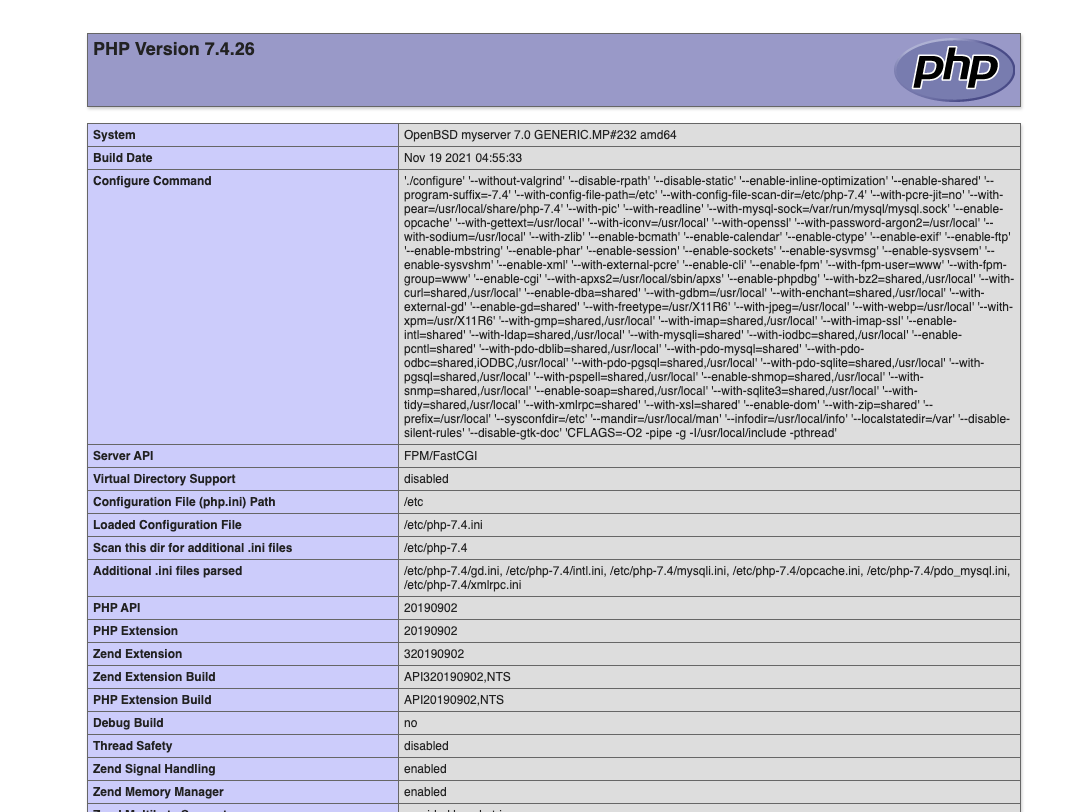
OpenBSD 7, Nginx, PHP-FPM (FastCGI Process Manager), and MySQL (OEMP) work as a collection to form a web stack that makes it possible to run dynamic applications on a server. Nginx runs as the web server, FastCGI process manager (PHP-FPM) adds dynamic processing for PHP scripts, and MySQL works as the database server.
In this article, you will install Nginx, PHP with PHP-FPM, and MariaDB as the drop-in replacement MySQL on OpenBSD 7.
Prerequisites
Deploy a Vultr OpenBSD 7 server and SSH to the server as root. Then, update the server.
# pkg_add -u1. Install Nginx
By default, Nginx is available in the openBSD7 repository packages. Install it with the following command:
# pkg_add nginxEnable Nginx to start at boot time.
# rcctl enable nginxStart the Nginx web server.
# rcctl start nginx2. Install PHP
Install PHP.
# pkg_add phpSelect your preferred version based on applications you intend to run. For system-wide compatibility, install PHP 7.4 (option 2).
Ambiguous: choose package for php
0: <None>
1: php-7.3.33
2: php-7.4.26
3: php-8.0.13PHP-FPM is automatically installed with the PHP package. Next, you have to start it up and allow it to run when the server starts.
Enable PHP-FPM to run at boot time.
# rcctl enable php74_fpmStart PHP-FPM.
# rcctl start php74_fpm Install the necessary modules for PHP to connect to the MySQL server.
# pkg_add php-mysqli php-pdo_mysqlOutput:
Ambiguous: choose package for php-mysqli
0: <None>
1: php-mysqli-7.3.33
2: php-mysqli-7.4.26
3: php-mysqli-8.0.13
Your choice: 2You can also install other PHP modules commonly required by most web applications.
# pkg_add php-gd php-intl php-xmlrpcEnable PHP modules.
# cp /etc/php-7.4.sample/* /etc/php-7.43. Configure Nginx for PHP-FPM
Install Nano or your favorite text editor.
# rcctl pkg_add nanoEdit the main Nginx configuration file.
# nano /etc/nginx/nginx.confWithin the server { block, add the following lines of code for Nginx to pass all PHP processing to the PHP-FPM socket.
location ~ \.php$ {
try_files $uri =404;
fastcgi_split_path_info ^(.+\.php)(/.+)$;
fastcgi_pass unix:run/php-fpm.sock;
fastcgi_index index.php;
fastcgi_param SCRIPT_FILENAME $document_root$fastcgi_script_name;
include fastcgi_params;
}Save and close the file.
Test the Nginx configuration.
# nginx -tOutput:
nginx: the configuration file /etc/nginx/nginx.conf syntax is ok
nginx: configuration file /etc/nginx/nginx.conf test is successfulEdit the main PHP-FPM configuration file.
# nano /etc/php-fpm.confConfirm that PHP-FPM connects through the socket /var/www/run/php-fpm.sock, and also runs with the user, group www.
; Unix user/group of processes
; Note: The user is mandatory. If the group is not set, the default user's group
; will be used.
user = www
group = www
; The address on which to accept FastCGI requests.
; Valid syntaxes are:
; 'ip.add.re.ss:port' - to listen on a TCP socket to a specific IPv4 address on
; a specific port;
; '[ip:6:addr:ess]:port' - to listen on a TCP socket to a specific IPv6 address on
; a specific port;
; 'port' - to listen on a TCP socket to all addresses
; (IPv6 and IPv4-mapped) on a specific port;
; '/path/to/unix/socket' - to listen on a unix socket.
; Note: This value is mandatory.
; If using a TCP port, never expose this to a public network.
listen = /var/www/run/php-fpm.sock4. Install MariaDB
Install the MariaDB service.
# pkg_add mariadb-serverInitialize the database server to create necessary binaries and system tables.
# mysql_install_dbStart the MySQL daemon.
# rcctl start mysqldSecure MySQL by setting a new root password and removing insecure defaults.
# mysql_secure_installation You will receive multiple prompts, accept decisively to tighten your database server security.
Switch to unix_socket authentication [Y/n]
Change the root password? [Y/n]
Remove anonymous users? [Y/n]
Disallow root login remotely? [Y/n]
Remove test database and access to it? [Y/n]
Reload privilege tables now? [Y/n] Enable MySQL to start at boot time.
# rcctl enable mysqld5. Test the Installation
By default, Nginx uses the /var/www/htdocs directory as webroot. Create a new PHP sample file in that directory to test the web server.
# nano /var/www/htdocs/test.phpPaste the following PHP code:
<?php
phpinfo();
?>Enter your server's public IP address in a web browser and load the test.php file. Your output should be similar to:

Congratulations, you have successfully installed Nginx, MySQL, and PHP-FPM on your OpenBSD 7 server.